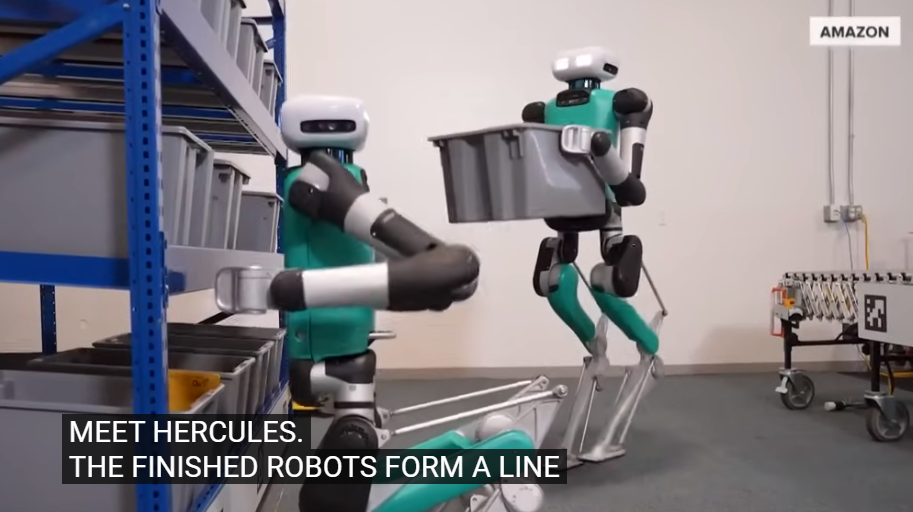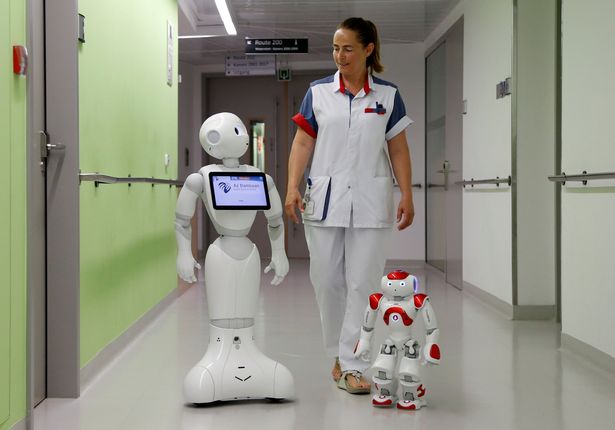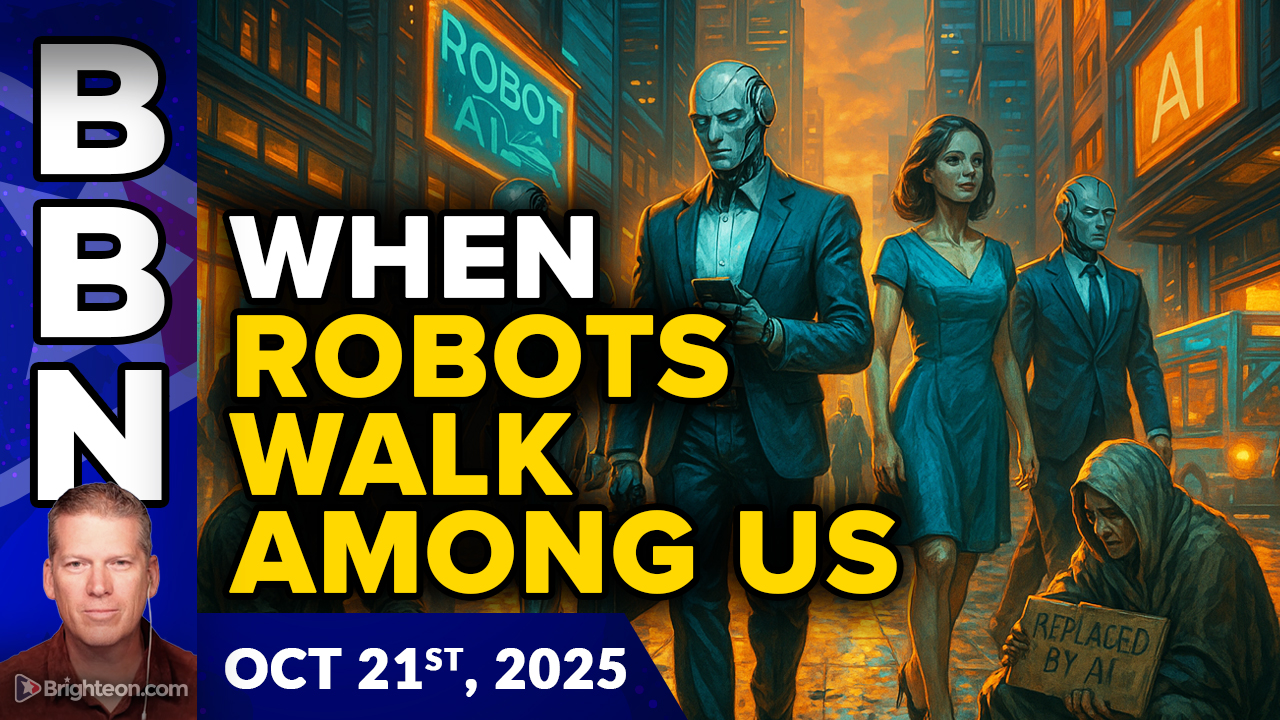Amazon’s robot revolution: Leaked documents reveal plan to replace 600,000 jobs by 2033
10/23/2025 / By Kevin Hughes

- Leaked documents reveal Amazon aims to automate 75 percent of fulfillment operations by 2033, eliminating 600,000 U.S. jobs it otherwise would have hired, with 160,000 cuts by 2027 alone, saving billions.
- Facilities like Shreveport, Louisiana, have already cut staffing by 25 percent using robots. Amazon plans to replicate this model in 40+ warehouses by 2027, retrofitting older sites with automation.
- Amazon executives reportedly avoid terms like “automation” and “AI,” preferring euphemisms like “advanced technology” and “cobots” to soften backlash, while workers remain uninformed about looming job losses.
- Economists warn Amazon’s automation could trigger industry-wide job destruction, disproportionately harming Black and Latino workers. Unions condemn the move as “corporate greed on steroids.”
- Walmart and UPS are following Amazon’s lead, accelerating AI and robotics adoption. While Amazon claims automation creates higher-skilled jobs, critics argue displaced workers lack access to retraining, leaving millions at risk.
Amazon, the e-commerce behemoth and second-largest private employer in the U.S., is accelerating its automation strategy with plans to replace hundreds of thousands of human jobs with robots, according to leaked internal documents obtained by the New York Times.
The leaked documents outline Amazon’s ambitious goal to automate 75 percent of its fulfillment operations by 2033, allowing the company to avoid hiring 600,000 U.S. workers it otherwise would have needed. By 2027 alone, Amazon expects to eliminate 160,000 positions, saving 30 cents per item processed—translating to $12.6 billion in cost reductions between 2025 and 2027.
One of the most striking projections in the documents is Amazon’s expectation that its product sales will double by 2033, meaning the company anticipates handling significantly more orders with far fewer human workers.
“The ramifications of Amazon replacing 600,000 human jobs with AI automation within the next five years are multifaceted and far-reaching, impacting the economy, society and potentially sparking worker revolts. This shift underscores the urgent need for policy reform, worker retraining and a societal reassessment of human relationships with technology,” BrightU.AI‘s Enoch said.
It added that Amazon’s plans to automate 600,000 jobs have the potential to cause significant economic, social and political disruption and it is crucial that policymakers, businesses and communities take proactive steps to mitigate these impacts and ensure a just transition to an AI-driven economy.
Robots rising: The Shreveport model
A key example of Amazon’s automation push is its Shreveport, Louisiana, fulfillment center, where robotic systems—including wheeled transporters and robotic arms—have already reduced staffing needs by 25 percent compared to traditional warehouses. The facility serves as a prototype for Amazon’s broader strategy, with plans to replicate the model in 40 more warehouses by 2027, starting with a site in Virginia Beach, Virginia.
Older warehouses are also being retrofitted for automation. A Stone Mountain, Georgia, facility currently employing 4,000 workers is expected to operate with 1,200 fewer staff after upgrades, relying more on temporary hires. Workers at these sites have reportedly been kept in the dark about the scale of automation, with one frustrated job seeker posting on Reddit about struggling to find openings despite months of searching.
The leaked documents reveal that Amazon executives are acutely aware of potential backlash. To soften public perception, the company has explored avoiding terms like “automation” and “AI” in favor of euphemisms such as “advanced technology” and “cobots” (collaborative robots). Employees involved in transitions have been instructed to “control the narrative” by emphasizing community benefits and innovation.
Amazon has denied instructing executives to avoid certain terminology, stating in a response to the leaks: “These documents are incomplete and do not reflect our overall hiring strategy.”
The company also highlighted plans to hire 250,000 seasonal workers for the upcoming holiday season and pointed to its mechatronics apprenticeship program, which has trained nearly 5,000 workers for higher-paying robotics maintenance roles.
Economic and labor fallout
Economists warn that Amazon’s automation push could have ripple effects across the economy. Daron Acemoglu, an MIT economist and Nobel Prize winner, told the New York Times: “Nobody else has the same incentive as Amazon to find the way to automate. Once they work out how to do this profitably, it will spread to others, too.”
He cautioned that Amazon risks becoming “a net job destroyer, not a net job creator.”
Labor unions have reacted fiercely to the revelations. Sara Nelson, president of the Teamsters, condemned the plans as “corporate greed on steroids,” vowing to intensify organizing efforts. Amazon’s workforce is disproportionately composed of Black and Latino employees, raising concerns that automation will disproportionately impact marginalized communities.
Amazon’s automation strategy reflects a broader corporate shift toward AI and robotics as a cost-cutting measure. Competitors like Walmart and UPS—which recently announced plans to cut 20,000 jobs—are likely to follow suit.
While Amazon insists automation will create new, higher-skilled jobs, critics argue that many displaced workers lack the training to transition into these roles. The company’s 19.50/hour warehouse jobs may soon be replaced by 24.45/hour robotics technician positions, but the barrier to entry remains high.
Amazon’s leaked documents confirm what many workers have long suspected: The company sees robots as the future—and humans as expendable. As automation accelerates, the U.S. labor market faces a seismic shift, with blue-collar jobs at greatest risk.
The question now is whether policymakers, labor advocates and corporations can ensure that automation benefits workers—rather than leaving millions behind. For now, Amazon’s warehouses hum with robotic arms, while the humans who once filled those roles face an uncertain future.
Watch the video below about Amazon debuting its fully autonomous warehouse robot.
This video is from the High Hopes channel on Brighteon.com.
Sources include:
Submit a correction >>
Tagged Under:
AI, Amazon, automation, Big Tech, cobots, conspiracy, e-commerce, future tech, human workforce, labor market, robotics, robots, tech giants, technocrats, warehouses
This article may contain statements that reflect the opinion of the author
RECENT NEWS & ARTICLES
COPYRIGHT © 2017 FUTURETECH.NEWS
All content posted on this site is protected under Free Speech. FutureTech.news is not responsible for content written by contributing authors. The information on this site is provided for educational and entertainment purposes only. It is not intended as a substitute for professional advice of any kind. FutureTech.news assumes no responsibility for the use or misuse of this material. All trademarks, registered trademarks and service marks mentioned on this site are the property of their respective owners.



















